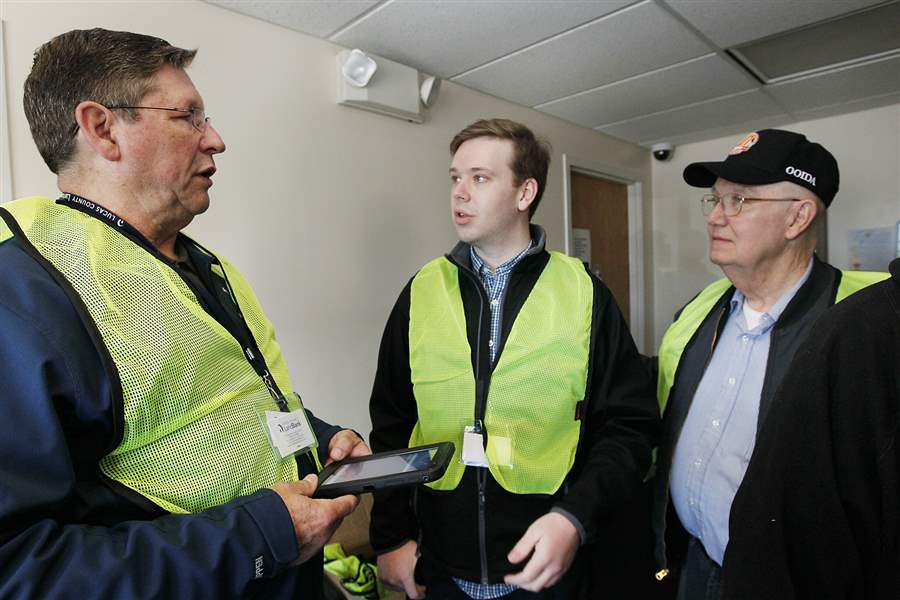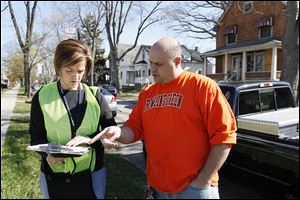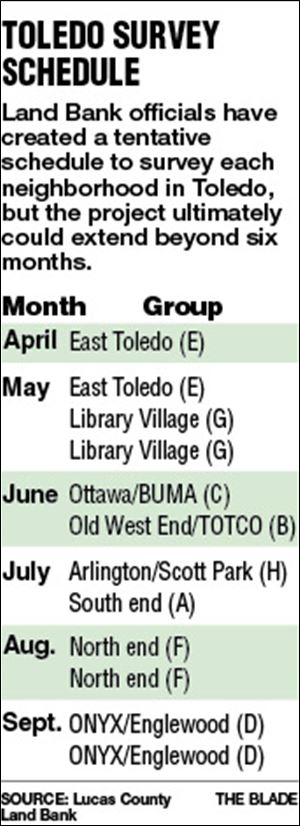
Land Bank kicks off neighborhood project
Volunteers hit Toledo streets for ambitious survey
5/4/2014
Toledo Land Bank volunteers Paul J. Gibbs, left, and Don Wiebold, right, both of East Toledo discuss the Toledo Survey with David Mann, center, of Toledo.
THE BLADE/JETTA FRASER
Buy This Image

Toledo Land Bank volunteers Paul J. Gibbs, left, and Don Wiebold, right, both of East Toledo discuss the Toledo Survey with David Mann, center, of Toledo.
The Lucas County Land Bank is beginning what some call a monumental task — identifying and surveying vacant and abandoned properties and lots in the city of Toledo.
The Toledo Survey, as it is called, is the largest undertaking that this six-person county department has taken on since its inception in 2010. The Land Bank primarily plans to use volunteers to collect the information on the vacant properties by visiting each neighborhood in the city.
“It’s hard work, but it’s visiting each property [and] doing a basic commission survey of it — 100,000 parcels is our aspirational goal,” said David Mann, Land Bank president.
Toledo Neighborhoods Director Tom Kroma said he believes this is the first time this kind of comprehensive snapshot of all the city neighborhoods has been gathered at one time.
Mr. Kroma said owners of vacant structures are required by law to list them in the city’s vacant-property registry each year, but oftentimes owners fail do so. So far this year, 388 properties have been registered as vacant. By the end of 2013, some 1,187 properties were listed.
The Toledo Survey is a more comprehensive approach that will give county and city officials a more realistic assessment of not only the number of vacant properties but also the condition of the dwellings and lots.

“This will give us at least a benchmark to be able to look at the problem. This will give us a number,” said Cyndi Geronimo, director of community engagement for the Land Bank.
The Land Bank, which is funded by penalties paid by delinquent property taxpayers, acquires tax-delinquent vacant and foreclosed properties and works to find a use for them — be that demolition, selling a vacant lot to a neighbor, or selling the parcel to a community group.
The bank also works with the city’s nuisance abatement department to raze blighted homes to try to stabilize the older Toledo neighborhoods. The Land Bank only has been acquiring properties since February, 2011, but this project is a step beyond what it has done in the past.
Ms. Geronimo said the data would be layered with other information used to determine if a property is truly abandoned, such as looking at water and other utility records on the property.
Land Bank officials plan to use the information to determine how to spend a $6 million grant from the Ohio Financing Agency. The grant came from money that was repurposed from the government’s foreclosure-prevention program, Mr. Mann said.
“This money is not being used for the survey. The survey is helping us prioritize where we want to spend the grant money, to identify where the most need is, where we can be strategic,” he said.
The grant will fund the demolition of about 600 structures, Ms. Geronimo said.

Amy Tingley of Oregon speaks to Jason Ribby, East Toledo homeowner. Ms. Tingley is one of the first volunteers assisting with the Toledo Survey.
First day out

The goal is to complete the survey during the next six months, with work happening primarily on Saturdays. Ms. Geronimo readily admits this is an aggressive timetable for a project of such a large scale, but she says she’s an optimist.
She is also pragmatic enough, however, to admit that the timetable will likely have to be adjusted as they learn more about how the mechanics will play out now that the volunteers are hitting the streets.
The survey kicked off April 26 in East Toledo, which contains some 11,000 parcels, said Ms. Geronimo. She was hoping for at least 80 volunteers, but on the first day only eight volunteered.
Ms. Geronimo is relying on organizations in each neighborhood that are already working on revitalization efforts to reach out to their network of volunteers or concerned residents and recruit them for the project.
Jodi Gross, community builder at the East Toledo Family Center, took part in the first group that surveyed a section of East Toledo.
She said they may have to adjust their tactics because potential volunteers tend to be busy on weekends. She suggested the Land Bank may have to be more flexible and let people work on the project when it’s convenient for them.
“I think 80 people might be a little unrealistic all at once,” she said.
Dressed in yellow safety vests and working in groups, Ms. Gross and the other seven volunteers spent two hours in a neighborhood near the Anthony Wayne Bridge, on Potter, Walden, Nevada Streets, and Starr Avenue. They were armed with computer tablets that contained software created for this type of survey work. The volunteers answered a series of question on the tablet and that information was immediately captured in the database.
“It’s very user-friendly. Anybody can do it,” Ms. Gross said. “One question asked if it is residential, commercial, or other. Then it asked if it is occupied or vacant. Sometimes you can clearly see if it’s vacant.”
“This technology is playing a huge role in making this happen. I think the learning curve is small to get someone up to speed to do an accurate survey,” Mr. Kroma said.
The volunteers completed 110 parcels in a two-hour period, Mr. Mann said. The results from the first outing found 27 residential homes that looked empty and 10 vacant lots, he said. About six of them received a grade of F, which means the volunteer determined the structure was unsafe and hazardous.
Next neighborhoods
Land Bank officials said the next neighborhood to be surveyed after East Toledo is the the Library Village area in West Toledo, followed by: the Ottawa Park-BUMA neighborhoods, the Old West End-Toledo Old Town area, the Arlington-Scott park area, the old south end, the north end, and lastly the ONYX-Englewood neighborhoods near downtown.
Terry Glazer, chief executive director of United North community development corporation, called the survey a “noble effort” and said the database will be a useful tool for neighborhood planning. He expressed concern, however, about recruiting enough volunteers to get it done.
“It is certainly worthwhile to do if they can mobilize enough volunteers. Our neighborhood is 25,000 people and probably at least 7,000 or so houses. That would a challenge,” he said.
After the survey is complete, the plan is to break the information down and present it in small chunks to leaders to help with plans for improving each neighborhood, Ms. Geronimo said.
“The Land Bank is not going to solve all of Toledo’s big problems alone just by collecting this data, but if you can engage local partners to help us come together and start tackling problems. ... If we can get people to the table and instead of focusing on anecdotes and have some real information to share with them. ... We think people will be able to come together, but it’s going to be different for each block and for each neighborhood,” Mr. Mann said.
Those interested in volunteering should contact the Land Bank at 419-213-4293.
Contact Marlene Harris-Taylor at mtaylor@theblade.com or 419-724-6091.